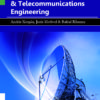The high-speed electrical machines are widely used in different industries, such as machine tools, aerospace engineering, autonomous power engineering, etc. Energy saving is an important aspect of sustainable development in modern society. In this field, electrical machines play a fundamental role in industrial, commercial and residential applications. It is well known that the energy consumed by electrical machines represents the largest part of the total consumption of electricity in the industrial sector. Higher efficiency can lead to a significant reduction of fossil fuel consumption and also of the environmental impact of human activities. The main task of the electrical machine (EM) design is to provide maximum power with a minimum energy loss and volume of active and constructive elements.
This book is intended to cover to the basics and development of high-speed electrical machines with high-coercitivity permanent magnets. It is considered in the application areas of high-speed electrical machines and their classifications. In addition, design problems of high-speed electrical machines are shown. In the next chapter, the book laid well-grounded information on a new type of capacitive machine. It also discloses the design approach of the motor drive for brushless DC motor and simple design approach for low torque ripple and high output torque synchronous reluctance motors. The forthcoming chapters take a narrative look on battery electric propulsion systems for competition racing applications; a review of the design and control of free-piston linear generator; design and fabrication of a high voltage lightning impulse generator; a novel flux focusing magnetically geared machine with reduced eddy current loss; and material optimization for a high power thermoelectric generator in wearable applications. It further presents a study on synchronous generator excitation control based on FLC. The book finally concludes the recent developments in the field of machine fault signature analysis with particular regard to vibration analysis. This intended scientific information will be of value to the students, scientists, researchers, and other stakeholders associated with the subject area.














Reviews
There are no reviews yet.